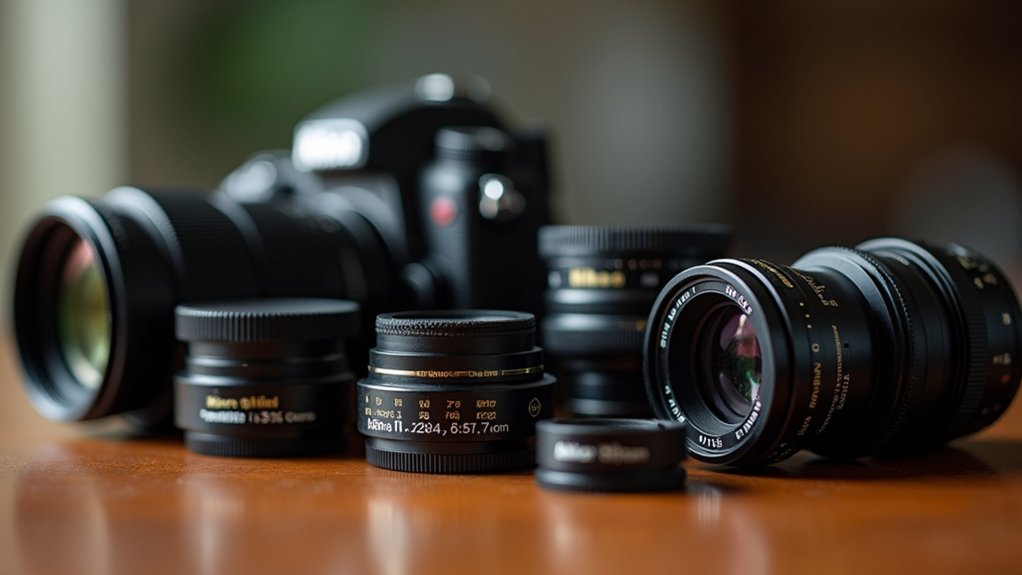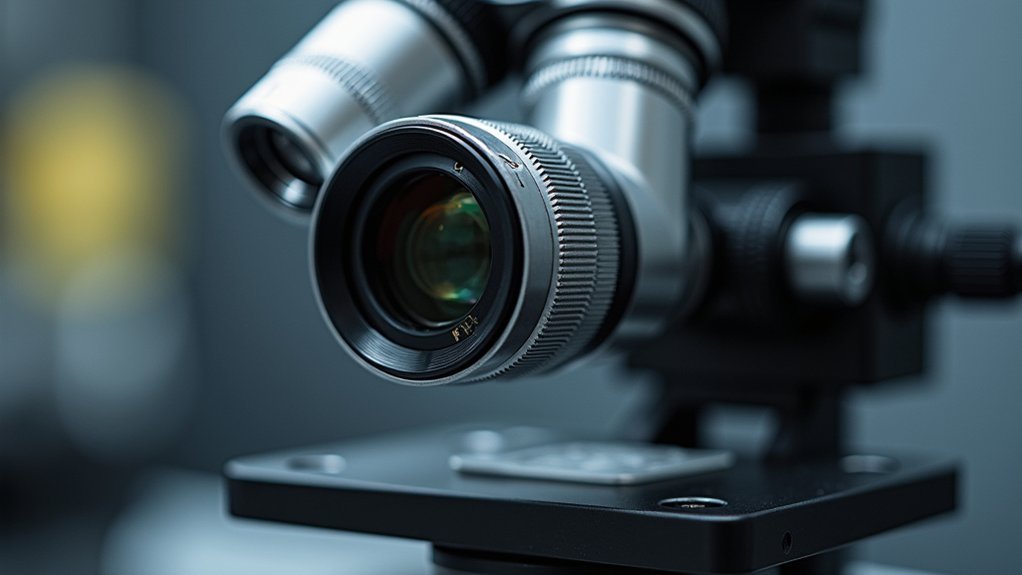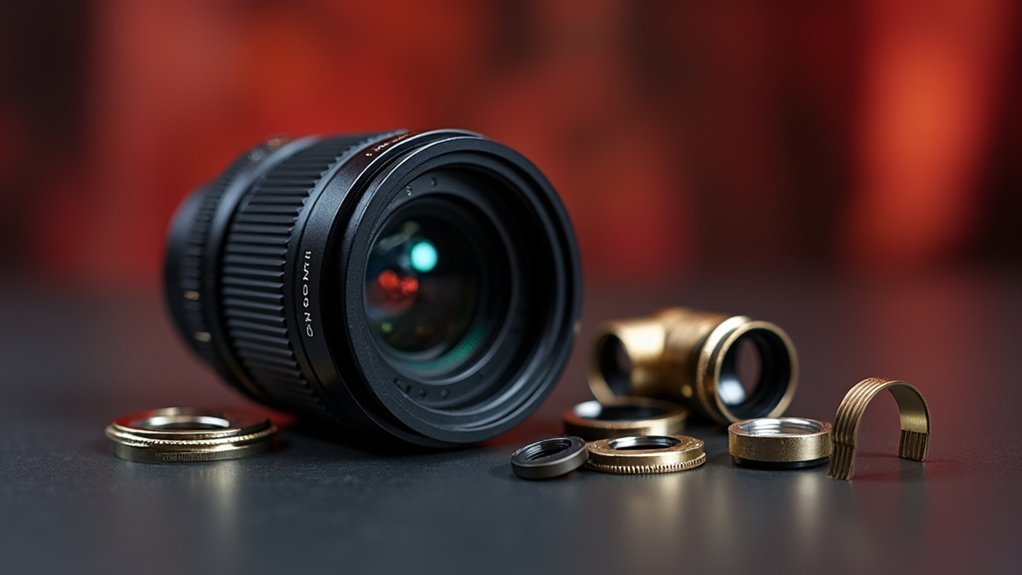To connect your Nikon eyepiece to a camera, you’ll need a T2 adapter specifically designed for Nikon F Mount cameras. These adapters accommodate eyepieces between 23mm and 60.75mm in diameter, with adjustable compression rings preventing damage to your equipment. For microscopes, verify compatibility with standard 1.25-inch eyepieces. You can purchase commercial T-Ring adapters starting around $20, or explore 3D printed custom solutions for unique setups. The right mount transforms your viewing experience into captured memories.
Understanding Nikon Eyepiece Compatibility Standards

Compatibility lies at the heart of successful camera-to-eyepiece mounting solutions. When working with Nikon eyepieces, you’ll find they feature a standard mount design that integrates seamlessly with Nikon F Mount cameras, particularly the F and F2 models. This standardization guarantees your adapters will connect securely without unwanted movement.
For proper fitting, your eyepiece diameter must fall between 23mm and 60.75mm to work with most telescope adapters. Many mounting systems utilize compression rings that accommodate various eyepiece sizes while preventing damage to delicate components.
The thoughtful design of Nikon’s eyepiece holders also supports corrective lenses, which is invaluable if you wear glasses.
If you can’t find a commercial solution that meets your specific needs, consider exploring 3D printed custom adapters tailored to your particular Nikon model.
Essential Adapters for Microscope-to-DSLR Connections
Connecting your Nikon DSLR to a microscope requires specialized adapters that bridge the gap between these two precision instruments. The most critical component is the T2 camera adapter, designed specifically to attach your Nikon body directly to the microscope’s optical system.
When selecting the right adapter for your setup, consider:
- Eyepiece compatibility – verify your adapter fits common 1.25-inch eyepieces or includes compression rings for variable diameters
- Adjustability features – look for adapters with fine-tuning capabilities to optimize magnification and focus
- Camera mount specificity – confirm that your chosen adapter matches your Nikon’s mount system
These adapters often include adjustable components that allow you to modify magnification settings while maintaining image quality.
Before purchasing, always check compatibility between your specific Nikon model and the adapter specifications.
Precision Mounting Options for Professional Microphotography

Professional microphotography demands mounting solutions that go beyond basic connectivity. When attaching your Nikon camera to microscope eyepieces, specialized adapters offer the precision required for extreme magnification work.
T2 adapters provide compatibility with standard 1.25-inch eyepieces, giving you flexibility in your eyepiece projection setup. For ideal focus control, consider variable length adapters that let you adjust projection distance—a critical factor in capturing microscopic details with your Nikon system.
Achieve precise microphotography with adjustable T2 adapters, essential for controlling projection distance in eyepiece-to-Nikon camera connections.
Adding a parfocalizing ring to your mount helps maintain consistent focus when switching between eyepieces.
Always match your adapter to the specific eyepiece diameter you’re using to prevent vignetting and maximize image quality. This attention to mounting precision will greatly improve your microphotography results, ensuring the full capability of your Nikon camera is realized.
Camera Bracket Solutions for Nikon Microscope Setups
While precision is essential for microphotography, securing your Nikon camera properly to the microscope eyepiece is the foundation of successful imaging.
The right bracket creates a stable connection between your camera body and microscope, enabling crisp, clear documentation of your specimens.
Most Nikon-compatible brackets offer:
- Adjustable mounts that accommodate various eyepiece diameters, ensuring compatibility across different microscope models
- T-Ring adapters specifically designed for Nikon camera bodies, simplifying the connection process
- Built-in focusing mechanisms to achieve ideal clarity in your microphotography
If you can’t find a commercial solution that meets your needs, consider exploring 3D printable models available on platforms like Thingiverse.
These DIY options allow you to create custom brackets tailored specifically to your Nikon microscope setup.
Selecting the Right T-Ring and Coupler Combinations

With your bracket solution secured, the next challenge involves finding compatible components that create a seamless connection between your Nikon camera and microscope eyepiece. Your Nikon setup requires a specific T-Ring designed for the Nikon F mount, with the standard M42 x 0.75mm thread specification.
| T-Ring Type | Compatible Coupler |
|---|---|
| Nikon F Mount | 1.25″ Standard Adapter |
| Nikon Z Mount | Z-Series Telescope Adapter |
| DSLR T-Ring | Universal Eyepiece Coupler |
| Mirrorless T-Ring | Precision Alignment Coupler |
| Wide-Field T-Ring | Zero-Vignetting Adapter |
When selecting your combination, you’ll need to match the T-Ring to your specific camera model while ensuring the coupler fits your eyepiece’s 1.25-inch port. This precision pairing minimizes vignetting and maintains proper alignment for ideal astrophotography results.
DIY vs. Commercial Mounting Solutions for Nikon Systems
Wondering if you’ll save money by crafting your own Nikon eyepiece adapter? You can print custom 3D mounting solutions tailored to your specific telescope and camera setup for a fraction of commercial costs.
Budget-conscious astronomers often find T-ring alternatives through online DIY communities, where printable designs accommodate various Nikon models while offering customization options not available in off-the-shelf products.
Homemade Adapters Worth It?
How practical is creating your own camera mount for a Nikon eyepiece when commercial options abound?
Homemade adapters offer customization advantages that commercial solutions can’t match, especially for unique camera and eyepiece combinations. With 3D printing technology, you’re able to design mounts tailored to your specific needs.
Consider these factors when deciding whether to build your own:
- Cost-effectiveness – DIY options typically cost a fraction of commercial mounts, though they’ll require more time investment.
- Customization potential – Create precise fits for uncommon eyepiece diameters or camera thread sizes.
- Learning curve – Expect some trial and error to achieve ideal alignment and focus quality.
While DIY solutions can work well, remember that commercial options generally provide more reliable, consistent results with less troubleshooting required.
Budget-Friendly T-Ring Alternatives
T-rings don’t have to break the bank when you’re connecting your camera to a Nikon eyepiece. Commercial T-Rings for Nikon systems typically start around $20, featuring standard M42 x 0.75 mm threads that guarantee compatibility with various telescope adapters.
If you’re looking to save even more, consider 3D printing your own T-Ring. This DIY approach allows you to customize dimensions for specific eyepiece sizes and camera models. You don’t need to own a printer—many local libraries and community makerspaces offer affordable 3D printing services.
While DIY solutions require more time and experimentation, they provide flexibility for unique setups.
Commercial T-Rings, on the other hand, deliver reliability and ease of use. Your choice ultimately depends on whether you value customization and cost savings over convenience and assured compatibility.
Print-Your-Own Mounting Solutions
Many photographers are discovering the creative freedom of 3D-printed mounting solutions for their Nikon eyepieces.
With STL files readily available on platforms like Printables.com, you’ll find DIY mounting solutions that cost considerably less than commercial options while offering customization for your specific setup.
When considering print-your-own mounting solutions versus commercial adapters like the Nikon DSLR Telescope Adapter Kit, weigh these factors:
- Custom DIY designs can be tailored to fit your exact eyepiece dimensions
- 3D-printed mounts allow for personalized ergonomics and functionality
- Printing your own mount provides a sense of accomplishment and deeper understanding of your gear
While commercial solutions offer immediate usability, the flexibility and satisfaction of creating a mount perfectly suited to your Nikon DSLR often outweighs the convenience.
Frequently Asked Questions
Do All Nikon Cameras Use a F-Mount?
No, not all Nikon cameras use F-mount. While most traditional DSLRs feature F-mount, newer mirrorless models use the Z-mount system. You’ll need to check your specific camera model for compatibility with lenses and accessories.
What Lens Mount Does Nikon Use?
Nikon uses the F-mount for DSLRs and SLRs (since 1959) and the Z-mount for mirrorless cameras. You’ll find the F-mount offers extensive lens compatibility, while the Z-mount provides better optical performance with its larger diameter.
Do All Nikon Lenses Fit All Cameras?
No, all Nikon lenses don’t fit all Nikon cameras. You’ll find F-mount lenses work with DSLRs while Z-mount suits mirrorless cameras. Older lenses may attach but might offer limited functionality on newer bodies.
Do All Nikon Cameras Have the Same Mount?
No, Nikon cameras don’t all have the same mount. Your DSLR models use the F mount (since 1959), while newer mirrorless Z series cameras use the Z mount, requiring adapters for F-mount lenses.
In Summary
You’ll need a specific camera adapter that matches your Nikon eyepiece diameter and camera mount type. Consider T-rings with the proper bayonet mount for your camera body paired with a compatible microscope adapter. Don’t forget to check thread sizes carefully before purchasing. Whether you choose commercial solutions or DIY options, ensuring precise alignment will dramatically improve your microphotography results and protect your valuable equipment.





Leave a Reply